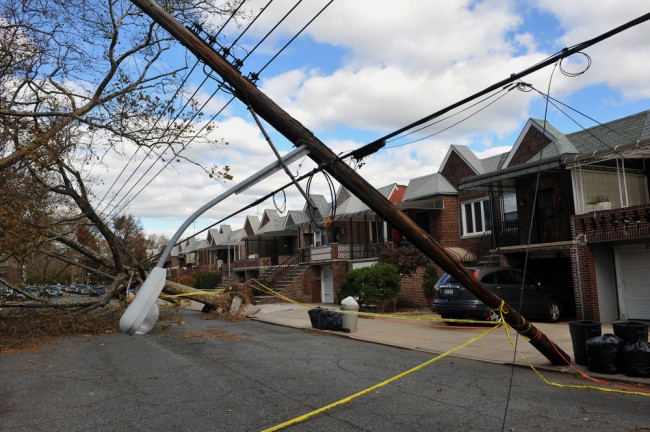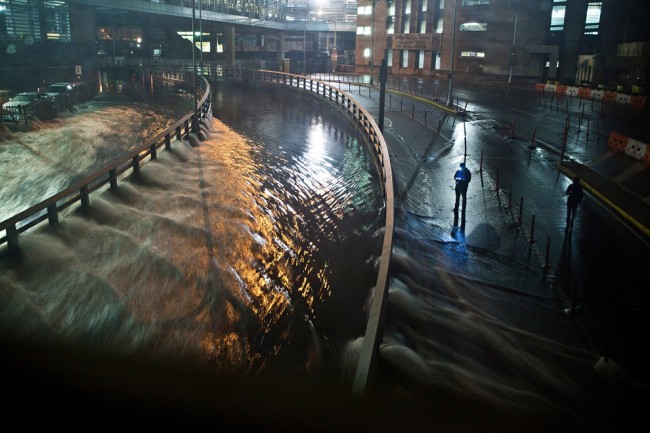
We are celebrating 15 years — and counting — of stories that are deeply researched and deeply felt, that build a historical record of what the city has been.
We are celebrating 15 years — and counting — of stories that are deeply researched and deeply felt, that build a historical record of what the city has been.
HERE COMES THE STORY OF THE HURRICANE
While the national news media has moved on from the devastation wrought by Hurricane Sandy, the storm’s aftermath continues to reveal the fragility and brittleness of many of the urban systems we rely on, as well as the resilient spirit of New Yorkers, especially among those dedicated to public service, like the MTA’s irrepressible Marc Mende, for example, featured in the video below.

Sheepshead Bay | Photo by Anton Oparin via Shutterstock
Recovery and Prevention
Of the $30 billion Governor Cuomo has requested for recovery efforts, $3.5 billion is for transportation, $1.65 billion is for housing, and $1 billion is for government employee overtime. So far the City has already spent $134 million on immediate recovery, and New York City’s businesses have reportedly lost $13 billion from the storm. Mayor Bloomberg has also announced emergency capital funds of $200 million dollars going to schools shuttered from damage, and $300 million for hospitals. The mayor has waived all application and permit fees for reconstruction work, and announced a comprehensive new initiative, NYC Restore, that will provide one-stop locations for city as well as federal disaster relief and partner with local, non-profit community-based organizations.
With losses of this scale, it’s no wonder that most private insurers won’t touch flood insurance. Thus, the federal government’s flood insurance program is one of the world’s largest. But in four out of the past eight years, according to The New York Times, claims filed in flood-prone areas have greatly exceeded the premiums paid by homeowners in those areas. After Hurricane Katrina, the program fell $18 billion into debt. And the rising costs of post-Sandy reconstruction puts it at risk of running out of money once again. Perhaps this is yet another reason to shift our approach to natural disasters to include prevention techniques alongside relief and recovery. Disaster avoidance, particularly where floods are concerned, is a concept perfected by the Dutch, whose “peerless expertise and centuries of experience in battling water have been widely hailed in the United States as offering lessons for how New York … might better protect people and property from flooding. Dutch engineering companies are already pitching projects to fortify Manhattan against storms.” While Mayor Bloomberg has announced his doubts about the efficacy of flood protection schemes such as storm-surge barriers, Councilwoman Christine Quinn, presumed frontrunner in the race to replace him, declared on Tuesday that “It’s now crystal clear that we need to build protective structures.” The costs could amount to $20 billion, but Quinn says the federal government should be the primary financier. New York’s senators Charles Schumer and Kirsten Gillibrand have already sought to realize plans for flood defenses already approved by the Army Corps of Engineers. Once again, funding remains the key challenge.
Transportation
The city’s long delayed bike share system might be delayed further because of flooding. The bike and docking equipment was overwhelmed with six feet of water at Brooklyn Navy Yard storage facilities. Several subway lines in Lower Manhattan are still being restored, including the 1, J, and Z. The R trains won’t run under the East River for another two to three weeks; the lengthy tunnel has been pumped clear, but electrical fuses need replacing along the entire track. The Brooklyn Battery Tunnel, recently renamed the Hugh L. Carey Tunnel, is similarly being dried and repaired, but will reopen to all-but-truck traffic at 6am Monday morning. Check out the MTA video above, describing the process.
Housing / Hospitals
During Obama’s visit to the New York City area yesterday, he announced that Housing and Urban Development Secretary (and former HPD Commissioner) Shaun Donovan will represent the Obama administration in the complex coordination of New York state and local government efforts to develop an effective longterm rebuilding and recovery plan. One of Donovan’s first moves in this capacity was to reach out to real estate executives and ask for their support in securing vacant apartments for those in need of long-term relocation. As temperatures continue to plummet, more people are expected to seek shelter from the cold. Several of the hospitals evacuated during the post-storm blackout are still empty, and officials say openings are still weeks away. The closings put strain on other medical centers, and as one hospital director put it, “the current status of care in Manhattan is not sustainable for any length of time.”
Electricity
Eric Schneiderman, New York’s Attorney General, has issued subpoenaes for electrical utilities Con Ed and the Long Island Power Authority (LIPA), and will investigate both their preparation and their response to the storm. LIPA’s chief executive resigned recently over the controversy. A New York Times investigation found LIPA “repeatedly failed to plan for extreme weather, despite extensive warnings by government investigators and outside monitors.” Criticism of Con Ed has been less direct, a fact which Crain’s New York attempts to explain in its profile of Con Ed’s CEO, Kevin Burke.

Flooded Carey Tunnel | Photo by Andrew Burton via Boston.com
OBAMA ON CLIMATE CHANGE
Of course, recovering from Sandy will be for naught if it does not shake national leaders out of complacency on climate change. On Thursday, Governor Cuomo declared, “We will lead on climate change,” in an opinion piece for the New York Daily News. “Recent events demand that we get serious once and for all. We need to act, not simply react.” And the way the country voted last Tuesday argues that the re-elected president has a mandate to take aggressive action. Out went three of the “Flat Earth Five,” congressional representatives known for their disbelief in climate change, and in went 11 of the 12 “Climate Heroes.” (The 12th, Jay Inslee, is expected to win his race soon in Washington state) In addition, Al Gore has encouraged President Obama to utilize the momentum of his re-election and the lively post-Sandy discussions to push through bold measures on climate change.
At Wednesday’s press conference, Obama did promise to find a bipartisan solution, and Mayor Bloomberg released a statement saying, “I look forward to supporting that new effort in any way I can.” However, Obama’s strategy remains vague, and despite his acknowledgement of the growing challenge climate change presents, he added, “If the message is somehow we’re going to ignore jobs and growth simply to address climate change, I don’t think anybody is going to go for that. I won’t go for that.”
KLAUS JACOB ON SEA LEVEL RISE
Four years ago, Dr. Klaus Jacob, a climate scientist at Columbia University’s Lamont-Doherty Earth Observatory, wrote that “climate change and sea-level rise are inevitable, and early anticipation seems prudent,” outlining his lecture for the 2007-08 Architectural League series “Reimagining Risk.” Fast-forward to the present, and Jacob’s analysis of New York City’s vulnerability to increasingly more frequent and stronger storms and sea level rise has been proven. Noah Chasin wrote, in a response to that lecture recently re-published on the League website, that Jacob’s main message was less of a proposal for planning and policy solutions, and more of a call to action. Jacob wanted to remind us of our moral and ethical obligation to take steps to minimize future ecological disasters. “The need for a widespread, grassroots revolt against self-serving governmental policies has never been greater,” summed up Chasin.
Yesterday, Jacob spoke at a panel hosted by the Center for Architecture and the American Institute of Architects NY Chapter on potential rebuilding and redesigning solutions for New York City. While he once again put forth some infrastructure ideas, such as inflatable plugs to prevent flooding in tunnels, he maintained, “communities themselves need to band together to make the decision to stay, leave, remain the same, or change.”
You can watch Jacob’s full lecture for the Architectural League here.
The Roundup keeps you up to date with topics we’ve featured and other things we think are worth knowing about.
The views expressed here are those of the authors only and do not reflect the position of The Architectural League of New York.